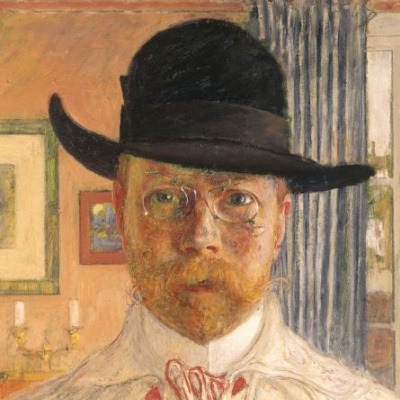

Carl Larsson
SE
197
Artworks
1853 - 1919
Lifespan
Artist Biography
Carl Olof Larsson (28 May 1853 – 22 January 1919) was a prominent Swedish painter and interior designer, celebrated as a key representative of the Arts and Crafts movement. Born in Gamla Stan, Stockholm, into extreme poverty, Larsson's early life was marked by hardship. His father, a casual laborer, was often absent or abusive, while his mother worked tirelessly as a laundress to support the family. Despite these grim circumstances, Larsson's artistic talent emerged early. At the age of thirteen, encouraged by a teacher at his school for poor children, he applied to the Royal Swedish Academy of Arts and was accepted. Initially feeling socially inferior and shy, Larsson gradually gained confidence, becoming a central figure in student life and earning his first medal for nude drawing. During this period, he also began working as a caricaturist and graphic artist to help support his parents financially.
After graduating from the Academy, Larsson worked as an illustrator for books, magazines, and newspapers. In 1877, he moved to Paris, hoping to establish himself as a fine artist. However, these years were fraught with frustration and lack of success. Larsson consciously avoided the burgeoning French Impressionist movement, preferring to associate with other Swedish artists. After spending two summers in Barbizon, a haven for plein-air painters, he relocated in 1882 to Grez-sur-Loing, a Scandinavian artists' colony outside Paris. This move proved to be a pivotal turning point in his life and career. It was in Grez that he met the artist Karin Bergöö, who would soon become his wife. There, Larsson also transitioned from oil painting to watercolors, a medium in which he would create some of his most important and defining works, marking a significant shift in his artistic style and approach.
Carl and Karin Bergöö married in 1883 and eventually had eight children (Suzanne, Ulf, Pontus, Lisbeth, Brita, Mats (who died in infancy), Kersti, and Esbjörn). His family became his primary source of inspiration and his favorite models. In 1888, Karin's father, Adolf Bergöö, gifted the couple a small house named Lilla Hyttnäs in Sundborn, Dalarna. Carl and Karin collaboratively transformed this cottage into a unique artistic and domestic haven, reflecting their distinct tastes and the needs of their growing family. Karin, a talented artist and designer in her own right, played a crucial role in the interior design of Lilla Hyttnäs, creating many of the textiles and furnishings that appeared in Carl's paintings. Through Larsson's widely circulated watercolors and books, Lilla Hyttnäs (now Carl Larsson-gården) became one of the most famous artist's homes in the world, epitomizing a cozy, vibrant, and distinctly Swedish approach to domestic life and interior design.
Larsson's artistic output was diverse, encompassing oils, watercolors, and large-scale frescoes. He is principally renowned for his charming and idyllic watercolors depicting his family life at Lilla Hyttnäs. These works, characterized by bright colors, detailed interiors, and tender portrayals of domestic scenes, resonated deeply with the public. However, Larsson himself considered his monumental works, particularly his frescoes in schools, museums, and other public buildings, to be his most significant artistic achievements. His magnum opus in this vein was *Midvinterblot* (Midwinter Sacrifice), a vast 6x14 meter oil painting completed in 1915. Commissioned for a wall in the Swedish National Museum, it was controversially rejected by the museum's board upon completion, a decision that deeply disappointed Larsson. Decades later, the painting was acquired by the museum and installed in its intended location.
Despite his personal preference for monumental art, Larsson's popularity soared due to the advancements in color reproduction technology in the 1890s. Swedish publisher Bonnier released books written and illustrated by Larsson, such as *Ett hem* (A Home, 1899), featuring full-color reproductions of his watercolors. The German edition, *Das Haus in der Sonne* (1909), became an enormous bestseller. These publications disseminated his vision of an ideal Swedish home far and wide, significantly influencing Swedish interior design and the concept of *folkhem* (the People's Home). Larsson's autobiography, *Jag* (I), completed shortly before his death and published posthumously (initially in a censored version), offered a candid and sometimes shocking account of his life. After suffering bouts of depression and a mild stroke, Carl Larsson died in Falun in January 1919, leaving behind a legacy as one of Sweden's most beloved and influential artists, whose work continues to celebrate family, home, and the beauty of everyday life.